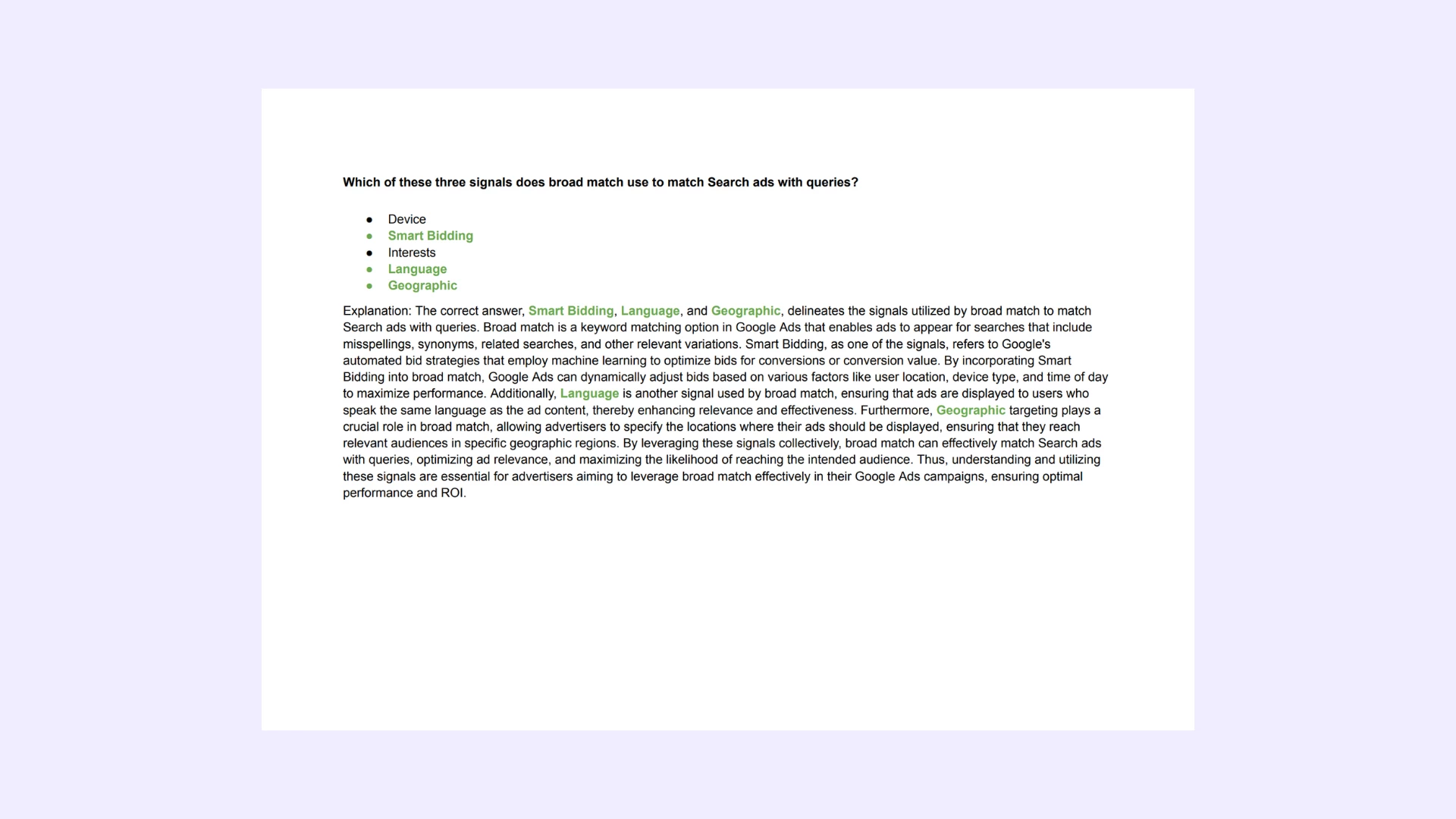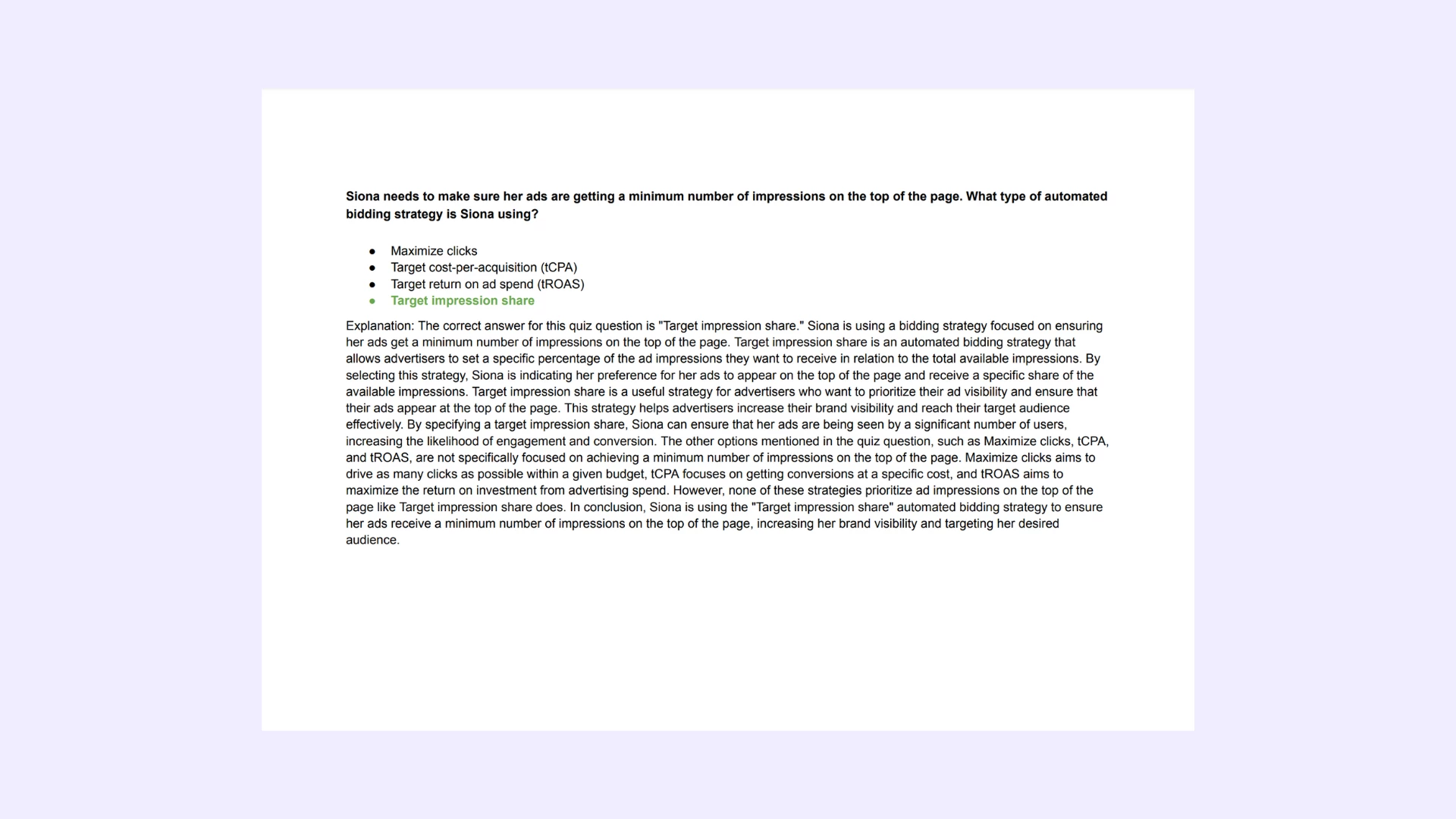This file contains all possible real exam questions with 100% correct and verified answers. Free updates included. Save your time.

Google SkillShop Bundle. Includes answers for every real Google SkillShop certification exam.
All-in-One: Get all Google SkillShop exams answers with explanations in one bundle. This package includes answers for every current Google SkillShop Platform certification. Regular updates Free updates. -> See what's included.
Questions | Answers | Explanations. Free Lifetime Updates.


Need a single cerification exam answers? Check out our -> list of certification exams answer keys. Learn Smarter. Obtain or Renew your certificates with peace of mind!
Below you’ll find some selected questions from the latest real certification exam. You can get an idea about the exam format and prepare for it smarter. Need all exam questions with answers? Consider downloading our file.
Google Tag Manager helps you manage your website in which of the following ways?
- Simplify and speed up tag deployment
- Specify when tags should fire
- Manage different versions of tags
- Increase audience reach
Google Tag Manager can only be used with Google tags
- True
- False
To create a tag implementation plan, what are the recommended guidelines?
- Decide which of your existing site tags you can move into Tag Manager
- Decide what static and dynamic values you’ll want to pass from your website
- Choose which tags can collect the data you need
- Decide which Tag Manager account to link to Google Analytics
Which Tag Manager tag would you use to track metrics and dimensions in Google Analytics?
- DoubleClick Floodlight Counter tag
- Google Ads Conversion Tracking tag
- Google Ads Remarketing tag
- Google Analytics Pageview tag
What is stored in a Tag Manager container?
- A grouping of all of your Tag Manager accounts
- A collection of variables defined in Tag Manager
- A Javascript object that holds data passed from your website
- A collection of website tags and triggers
What is a “container snippet” in Tag Manager?
- Javascript code placed on each page of your website
- A Javascript object that holds data passed from your website
- A collection of website tags and triggers
- Analytics tracking code
A Tag Manager account allows you to do which of the following?:
- Manage tags for one or more websites
- Manage user permissions in your Google Analytics account
- Connect multiple Tag Manager accounts to a single Google account
- Control access permissions to a Tag Manager account
What is a “trigger” in Tag Manager?
- A trigger determines which events fire on your website
- A trigger instantiates the data layer
- A trigger fires a tag in response to a website event
- A trigger publishes a tag to your website
What are the three parts of a trigger in Tag Manager?
- Variables, operators, and values
- Operators, tags, and variables
- Variables, operators, and the data layer
- Tags, values, and the push method
How do you enable a built-in variable in Tag Manager?
- Publish the built-in variable in the Publish Now area
- Create a user-defined variable in the Variables tab
- Select the built-in variable in the Variables tab
- Uncheck the built-in variable in the Variables tab
Passing exams is not a workout. Multiple attempts won’t make you stronger.
Save your time with our answer-sheets. Get certified in minutes.
When logging into Google Tag Manager for the first time, what needs to be set up?
- A Google Analytics account
- A Tag Manager account
- The data layer
- Cross-domain tracking
Where can the container code be found in Google Tag Manager?
- In a pop-up window after you create an account and container
- Under the “Accounts” section by clicking into the container
- Under “Admin” by selecting your container and clicking “Install Google Tag Manager”
- Under the “Versions” section by clicking into the tag
Which Tracking ID format should be used when setting up an Analytics Pageview tag?
- UA-123456-7
- 123456
- 123456-7
- UA-123456
What kind of variable should be used for a reusable Google Analytics property ID variable?
- User-defined Constant variable
- User-defined Data Layer variable
- Built-in Event variable
- Built-in Click Classes variable
Which are benefits of using the data layer in Tag Manager?
- Write and edit code in the GTM interface
- Pass data into third-party applications
- Use data to fire tags
- Encrypt data automatically
Where should the data layer object be placed in the website code?
- Before the container snippet
- After the container snippet
- Inside the container snippet
- At the bottom of your HTML
How are variables structured in the data layer?
- As Javascript cookies
- As variable types
- As containers
- As key-value pairs
Which can be used to populate information to the data layer?
- Use Javascript to pre-populate values in the data layer when a web page loads
- Use Google Ads to push information to the data layer
- Use Google Analytics to push information to the data layer
- Use a Javascript method to push values from your web page into the data layer
Data Layer variables automatically persist across different web pages
- True
- False
To pass static values from a website into Google Analytics Custom Dimensions using the data layer, which of these must be set up?
- A Custom Segment
- The data layer
- A Data Layer variable
- A Google Analytics tag with a Custom Dimension
The data layer “push” method allows you to do what?
- Push data from Google Analytics to your website
- Push data from your website into the data layer
- Push data from Google Ads to the data layer
- Push data from one Tag Manager account to another
To pass dynamic values from a website into Google Analytics Custom Metrics using the data layer, which of these must be set up?
- A Trigger
- The data layer
- A Data Layer variable
- A Google Analytics tag with a Custom Metric
To send Custom Dimension data with an Analytics Pageview tag, what do you need to add to the Pageview tag in Tag Manager?
- The Tag Manager account ID
- The Analytics property ID
- A Javascript push method
- The Custom Dimension index number
To send Custom Metric data with an Analytics Pageview tag, what do we need to add to the Pageview tag in Tag Manager?
- The Tag Manager account ID
- The Analytics property ID
- A Javascript push method
- The Custom Metric index number
What event type would you choose to track button clicks using an event trigger?
- Click
- Form
- Page View
- History Change
What kinds of website actions can trigger a Google Analytics event tag in Tag Manager?
- Submit button clicks
- Play button video clicks
- Menu selection
- Closing a web page
What kind of user-defined variable should you use to track the URL of a webpage in Tag Manager?
- Page Path variable
- URL variable
- Click Classes variable
- DOM element
What Tag Manager variable type should you use to track only the part of a URL after the hash sign?
- URL Port
- URL Query
- URL Fragment
- URL Path
Which built-in variable should you use to define an event trigger based on the class of a Submit button?
- Built-in Event variable
- Built-in Element variable
- Built-in Click Classes variable
- Built-in Click Target variable
To create an Google Ads Conversion tracking tag in Tag Manager, which of these is needed from your Google Ads account?
- Google Ads Account number
- Conversion Label
- Conversion ID
- Conversion Property
What would you put in the Conversion Value field to dynamically capture the conversion values associated with your Google Ads tag?
- A built-in Referrer variable that records conversion URLs
- A user-defined variable that records conversion amount
- The median amount users spend according to Analytics
- The projected amount users will spend according to Analytics variable that records conversion URLs
What does Google Analytics Dynamic Remarketing use to show website visitors ads for content they previously viewed?
- Hit and session attributes collected via the data layer
- Products the user has +1’d in Google Plus
- User information from the Analytics cookie
- Hit and session attributes collected from Google Ads
To set up Dynamic Remarketing in Tag Manager, where do you enable data collection for Advertising Features?
- Google Ads account admin settings
- Analytics account admin settings
- Tag Manager account admin settings
- Tag Manager dashboard
What does Google Ads use to generate dynamic ads based on a user’s past interactions with website products and services?
- Browser cookies
- Javascript methods
- Dynamic attributes
- User profiles
Where can you find a list of business-vertical attributes for Dynamic Remarketing?
- The Google Analytics Help Center
- The Google Analytics Admin area
- The Tag Manager Admin area
- The Google Ads Admin area
For Dynamic Remarketing, what kind of variable needs to be set up in Tag Manager to collect information in the data layer?
- Constant variable
- Data Layer variable
- Google Ads variable
- Event variable
For Dynamic Remarketing, what needs to be set up in Google Analytics to collect information from the data layer?
- Constant variable
- Data Layer variable
- Google Ads variable
- Event variable
For Dynamic Remarketing, if you wish to use the data layer to collect when a user adds a product to their shopping cart without refreshing the page, what Analytics track type would you use?
- Pageview
- Event
- Transaction
- Social
For Dynamic Remarketing, to set your tag to fire on a particular page, what should your trigger variable be set to?
- Page URL
- Referrer
- Click Classes
- Page Hostname



